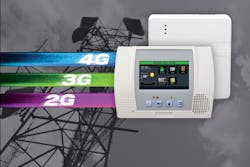MELVILLE, N.Y., June 14, 2012 – Honeywell (NYSE: HON) today announced it has crossed the 1 million subscriber threshold for GSM alarm radios. The radios are used to transmit signals to central monitoring stations – a milestone further indicative of consumers choosing digital communications technology for its ability to provide unique services that have redefined the modern-day security system.
Over the past few years, the rise of GSM – the world’s most-popular cell phone network – as a reliable alarm-communications path has opened the door to services that have made home and business security a bigger and more-visible part of daily routines. For instance, the ability to manage a security system from a smart phone or mobile tablet has allowed consumers to stay connected to their homes from any location. As a result, many home and business owners have practically made solutions such as Honeywell Total ConnectT Remote Services – which allows home and business owners to control security systems from any Internet-connected device – standard features on any alarm system.
“GSM technology was originally introduced as an alternative to standard, analog phone lines that were rapidly starting to be phased out of our homes and unreliable VoIP systems, but now it’s far more than an alternative – it’s easily a preferred choice,” said Gordon Hope, general manager of Honeywell’s AlarmNet communications network. “GSM networks are continuing to evolve, as we’re seeing with the advent of 3G and 4G radios, which means home and business owners will best be served using radios capable of handling a variety of network speeds. That has been one of the primary drivers of Honeywell’s product roadmap.”
Honeywell, for example, recently released its LYNX Touch 5100 self-contained system, which uses GSM communications technology. The system selects a 2G, 3G or 4G network – whichever is available in the immediate location. This approach helps ensure the best signal speed, reliability and system longevity in a world of rapidly changing communications networks. In the case that a 2G, 3G or 4G network is unavailable, SMS technology is employed as a back-up.
“Everyone knows that any technology is almost outdated the minute it leaves the store, but you can’t afford to have an outdated security system,” Hope said. “Our GSM solutions help shepherd in the next wave of alarm radios because it improves system longevity, even with a constant churn of technology. That peace of mind is hard to replicate.”
For more information, please visit www.honeywell.com/security.



